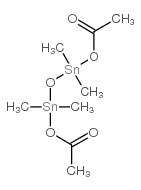5926-79-4
| Name | Bis(acetoxydimethyltin)oxide |
|---|---|
| Synonyms |
1,3-Diacetoxy-tetramethyl-distannoxan
2,4-Dimethyl-2,4-bis(acetyloxy)-2,4-distanna-3-oxapentane 2,4-Dimethyl-2,4-diacetoxy-2,4-distanna-3-oxapentane 1,1,3,3-tetramethyl-1,3-diacetoxydistannoxane MFCD00070453 EINECS 227-660-4 TETRAMETHYLDIACETOXYSTANNOXANE Bis-<acetoxy-dimethyl-stannyl>-aether Tetramethyl-1.3-diacetoxy-distannoxan 1,3-Bis-(acetyloxy)-1,1,3,3-tetramethyldistannoxane 1,3-diacetoxy-1,1,3,3-tetramethyldistannoxane Bis-<acetoxy-dimethyl-stannyl>-aether (Tetramethyl-1.3-diacetoxy-distannoxan) |
| Boiling Point | 117.1ºC at 760 mmHg |
|---|---|
| Melting Point | 240ºC |
| Molecular Formula | C8H18O5Sn2 |
| Molecular Weight | 431.62800 |
| Flash Point | 40ºC |
| Exact Mass | 433.92000 |
| PSA | 61.83000 |
| LogP | 1.53280 |
|
Section 1: Product Identification Chemical Name:Tetramethyldiacetoxystannoxane CAS Registry Number:5926-79-4 Formula:[(CH3)2(CH3CO2)Sn]2O EINECS Number:227-660-4 Chemical Family:organotin compound Synonym:1,1,3,3-Tetramethyl-1,3-bis(acetyloxy)distannoxane
Section 2: Composition and Information on Ingredients IngredientCAS NumberPercentACGIH (TWA)OSHA (PEL) Title Compound5926-79-4100%2mg/m3 (as Sn)2mg/m3 (as Sn) Section 3: Hazards Identification Organo tin compounds may act as delayed poisons, causing headache, dizziness; psycho-neurologic Emergency Overview: disturbances; sore throat, vomiting; urine retention; vision impairment; skin burns, liver and kidney damage. Primary Routes of Exposure:Ingestion, inhalation, skin, eyes Eye Contact:Causes severe irritation of the eyes. Causes slight to mild irritation of the skin. Prolonged contact may dry the skin and lead to rashes or more Skin Contact: severe irritation. Irritating to the nose, mucous membranes and respiratory tract. High doses may cause long term neurological Inhalation: damage. Delayed and permanent psycho-neurologic disturbances; impairment of vision, unsteadiness, nausea and Ingestion: vomiting. Irritating to skin, eyes and respiratory tract.Ingestion of certain organotin compounds may cause delayed Acute Health Affects: poisoning (4 days) with cerebral edema causing damage to the central nervous system. Repeated exposure to certain organic tin compounds may cause problems with vision, skin, respiratory Chronic Health Affects: system, central nervous system, liver, kidneys, urinary tract, and blood. NTP:No IARC:No OSHA:No SECTION 4: First Aid Measures Immediately flush the eyes with copious amounts of water for at least 10-15 minutes. A victim may need Eye Exposure: assistance in keeping their eye lids open. Get immediate medical attention. Wash the affected area with water. Remove contaminated clothes if necessary. Seek medical assistance if Skin Exposure: irritation persists. Remove the victim to fresh air. Closely monitor the victim for signs of respiratory problems, such as difficulty Inhalation: in breathing, coughing, wheezing, or pain. In such cases seek immediate medical assistance. Seek medical attention immediately. Keep the victim calm. Give the victim water (only if conscious). Induce Ingestion: vomiting only if directed by medical personnel. SECTION 5: Fire Fighting Measures Flash Point:no data Autoignition Temperature:no data Explosion Limits:no data Extinguishing Medium:carbon dioxide or dry powder Fire fighters should be equipped with a NIOSH approved positive pressure self-contained breathing apparatus Special Fire Fighting Procedures: and full protective clothing. Hazardous Combustion andcarbon monoxide, carbon dioxide, soot, organic fumes and tin compounds. Decomposion Products: Unusual Fire or Explosion Hazards: No unusual fire or explosion hazards. SECTION 6: Accidental Release Measures Small spills can be mixed with vermiculite, ground limestone, sodium carbonate or other suitable Spill and Leak Procedures: noncombustible adsorbent and swept up. SECTION 7: Handling and Storage Handling and Storage:Store in a cool, dry, well ventilated area away from heat and direct sunlight. Keep containers tightly sealed. SECTION 8: Exposure Controls and Personal Protection Eye Protection:Always wear approved safety glasses when handling a chemical substance in the laboratory. Skin Protection:Wear protective clothing and gloves. Consult with glove manufacturer to determine the proper type of glove. Ventilation:Work with this product in a well-ventilated area, preferably a fume hood. If ventilation is not available a respirator should be worn. The use of respirators requires a Respirator Respirator: Protection Program to be in compliance with 29 CFR 1910.134. Ventilation:Work with this product in a well-ventilated area, preferably a fume hood. Additional Protection:No additional protection required. SECTION 9: Physical and Chemical Properties Color and Form:white pwdr. Molecular Weight:431.61 Melting Point:240° Boiling Point:no data Vapor Pressure:no data Specific Gravity:no data Odor:not determined Solubility in Water:insoluble SECTION 10: Stability and Reactivity Stability:moisture sensitive Hazardous Polymerization:no hazardous polymerization Conditions to Avoid:none Incompatibility:strong oxidizing agents and halogens Decomposition Products:carbon monoxide, carbon dioxide, tin oxide, and organic fumes. SECTION 11: Toxicological Information RTECS Data:No information available in the RTECS files. Carcinogenic Effects:No data available Mutagenic Effects:No data available Tetratogenic Effects:No data available SECTION 12: Ecological Information Ecological Information:No information available SECTION 13: Disposal Considerations Disposal:Dispose of according to federal, state, and local regulations. SECTION 14: Transportation Shipping Name (CFR):Non-hazardous Hazard Class (CFR):NA Additional Hazard Class (CFR):NA Packaging Group (CFR):NA UN ID Number (CFR):NA Shipping Name (IATA):Non-hazardous Hazard Class (IATA):NA Additional Hazard Class (IATA):NA Packaging Group (IATA):NA UN ID Number (IATA):NA SECTION 15: Regulatory Information TSCA:Not listed in the TSCA inventory. SARA (Title 313):Title compound not listed. Second Ingredient:none SECTION 16 - ADDITIONAL INFORMATION N/A |
| RIDADR | UN3146 |
|---|---|
| Packaging Group | III |
| Hazard Class | 6.1 |
